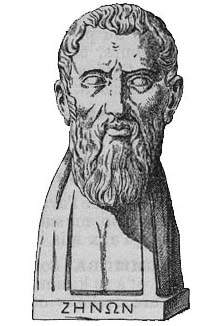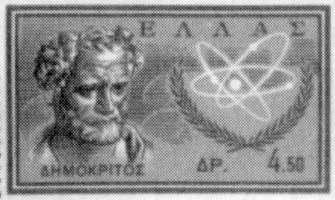
 |
THE GREEK HEROIC AGE II | |
| History | ||
| 1. HIPPIAS OF ELIS | ||
| Unlike the Pythagoreans, Hippias de Elis (460 B.C.) was a Sophist; in other words he earned his living by teaching his disciples. This is mentioned in Plato's Dialogues, where he is described as having little substance, earning more money than his peers and somewhat proud in character. Proclus ascribed to him the invention of the first curve, which is different to the circumference, known as the trisectrix or quadratrix of Hippias, which allows the angle to be divided into three equal parts. It can also be used to square the circle although Dinostratus gave a clear demonstration of this in the following century. | ||
|
||
|
||
| 2. PHILOLAUS OF TARENTUM | |
| Instructed
by one of Pythagoras' followers who had fled Croton and sought refuge
in Tarentum, Philolaus is said to be responsible for the first
written account of Pythagoreanism from which Plato
taught himself about the Pythagorean school.
He believed in numerical mysticism and his work included a description
of Pythagorean cosmology and his definition of 'tetractys'.
Right: Stamp from San Marino, which pays homage to Pythagoras. |
 |
| 3. ARCHYTAS OF TARENTUM | ||
| Archytas was a disciple of Philolaus who wrote about proportions and studied arithmetic, geometric and harmonic mean. He was very interested in the teaching of music in the education of children. The following areas in the mathematical quadrivium have been ascribed to him: arithmetic (numbers at rest), geometry (magnitudes at rest), music (numbers in motion) or astronomy (magnitudes in motion). He is also attributed with a three-dimensional solution to the duplication of the cube. | ||
|
||
Hippocrates had already shown that duplication of the cube was possible when curves were used which satisfied the following equations a/x=x/y=y/2a Archytas found the solution through the intersection of a cone, a cylinder and a torus. The window shows Menaechmus' solution (IVth century B.C.). He discovered the conic sections (the ellipse, the hyperbola and the parabola) which can be used to prove Hippocrates' equation: the x-coordinate of the point of intersection of the two parabolas tells us the segment we're looking for. |
||
|
|
||
| 5.- HIPPASUS OF METAPONTUM | ||
Hippasus, a contemporary of Philolaus, was expelled from the Pythagorean society for revealing some of their secrets. Some believe that they were to do with incommensurability, which demonstrated that when a longer segment was compared to a shorter one the result was neither a whole number or one of its ratios (which are now called irrational numbers). For example when comparing the diagonal of a square, a cube or a regular pentagon with its side. A similar thing happens when the diagonals of a regular pentagon are joined together to produce another smaller pentagon inside, a process which can be repeated indefinitely. However, the Pythagorean belief that "numbers constituted everything" came up against a serious problem. As the ratio of the diagonal to the longer segment was neither a whole nor a rational number it couldn't therefore be conceived as a number at all. |
||
We have drawn the diagonal lines inside the pentagon. Each diagonal cuts another at a certain point giving us 5 new points which are then joined together to form another pentagon. Each
one of these points has a special property: it divides the diagonal into
two segments (one longer than the other) and the ratio (quotient) of the
diagonal to the longer side is equal to the ratio of the longer side to
the shorter side. This ratio is known as the GOLDEN NUMBER,
which is an irrational number which can be found by solving a quadratic
equation. Its value is |
||
| 6.- ZENO OF DE ELEA (450 B.C.) | |
|
Zeno attacked Pythagorean beliefs with his paradoxes based on the dialectical method of reasoning. Using his opponents premises as a starting point for his arguments he reduced them to an absurdity (reductio ad absurdum). As a result, he was able to conclude that motion did not exist. His most well-known paradoxes are: the Dichotomy, the Achilles, the Arrow and the Stade. The Stade paradox: Achilles is racing against a tortoise which is a complete stade ahead of him and is running at a speed ten times faster than the animal. However, when Achilles has run the length of the stade the tortoise has run a tenth of the stade. Then, when Achilles has run 1/10 of the stade the tortoise, which is 1/10 of the stade ahead has run a further 1/100. When Achilles has run this 1/100 of the stade the tortoise, which is now 1/100 of the stade ahead has run a further 1/1000 etc. Therefore, Achilles never catches up with the tortoise. The fact that this was impossible caused Zeno's reasoning to be doubted. However, his contemporaries were unable to refute his arguments. Nevertheless, the idea of using infinitesimal infinities to prove theories was systematically rejected until the following century. |
 |
| 7.- DEMOCRITUS OF ABDERA (460 B.C.) | ||
|
As well as being known as a materialistic philosopher for his atomic doctrine, Democritus of Abdera was also a reputed geometer. He travelled extensively and wrote a number of mathematical works. According to Cicero, his works were clearly written and even more poetical than the poets. Although non of his actual writings still exist today we do know some of their titles: On Numbers, On Geometry, On Tangencies, On Mappings and On Irrationals. His greatest contribution to mathematics is known as the infinitesimal method. He used this method to prove that the volume of a pyramid is equal to a third of the area of the base multiplied by the height, something that the Egyptians has already been aware of but not proven. It appears that Democritus divided a prism into three pyramids of equal base area and height and sliced an infinite number of cross sections which were parallel to the base. He then matched these sections up and found that the volumes were equal. This gave an immediate conclusion but it can also be argued that the shape could have been a step pyramid instead of a smooth-surfaced one. Another problem he faced was the fact that he had solved the problem using a new method based on infinitesimal calculations. |
||
 |
|
|
| Rosa Jiménez Iraundegui | ||
 |
||
| Spanish Ministry of Education. Year 2001 | ||